It’s that time of the year again. The winning images of the Sony World Photography Awards have been revealed. It’s the eight edition of the competition and, as usual, the Italians made a killing and take a large portion of the awards, there is a fair deal of suffering, at least one of the awards goes to an image featuring Palestinians being bullied by soldiers with sophisticated weapons (this year however, the photos are joyful), and it is always strange to look at the photos and realize that the main events of the year before have almost already been erased from consciences.
I’ve received the press images this morning, selected the ones i found most striking, made my community proud and copy/pasted the description and then i hit publish:
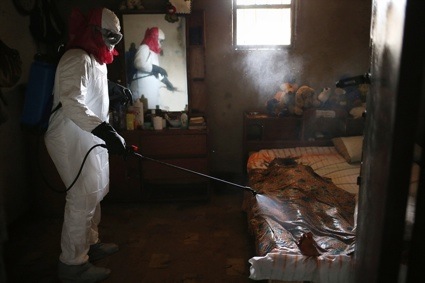 John Moore (L’Iris d”or, photographer of the year), A burial team sprays disinfectant over the body of a woman suspected of dying of Ebola in her home. From the series Ebola Crisis Overwhelms Liberian Capital
John Moore (L’Iris d”or, photographer of the year), A burial team sprays disinfectant over the body of a woman suspected of dying of Ebola in her home. From the series Ebola Crisis Overwhelms Liberian Capital
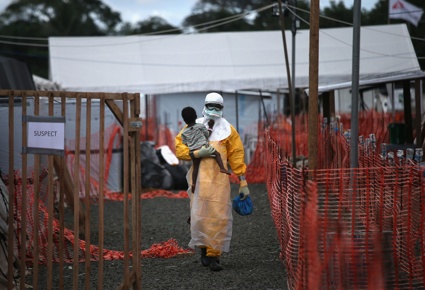 John Moore (L’Iris d”or, photographer of the year), An MSF health worker in protective clothing carries a sick girl at an Ebola treatment center. From the series Ebola Crisis Overwhelms Liberian Capital
John Moore (L’Iris d”or, photographer of the year), An MSF health worker in protective clothing carries a sick girl at an Ebola treatment center. From the series Ebola Crisis Overwhelms Liberian Capital
In the summer of 2014 Monrovia, Liberia became the epicenter of the West African Ebola epidemic, the worst in history. Although previous rural outbreaks were more easily contained, once the virus began spreading in Monrovia’s dense urban environment, the results were described by Medecins Sans Frontieres as “catastrophic”. With a tradition of burial rites that include the washing of the dead bodies of loved ones, Liberians became infected at alarming rates. Only a decade after a long civil war, Liberia’s fragile health system was unable to cope, international agencies were slow to react, and the country struggled.
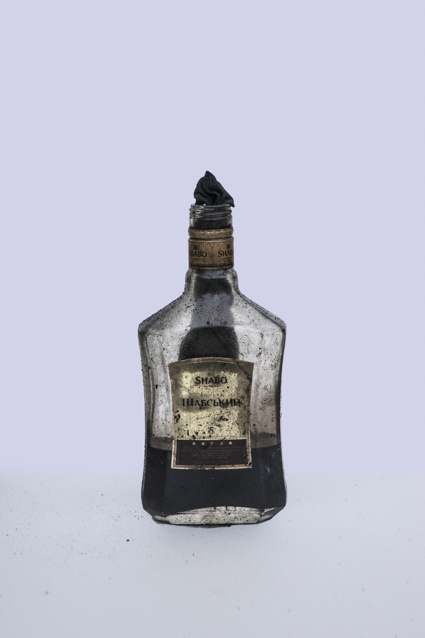 Donald Weber (Still Life Photographer of the Year), Untitled. From the series Molotov Cocktails
Donald Weber (Still Life Photographer of the Year), Untitled. From the series Molotov Cocktails
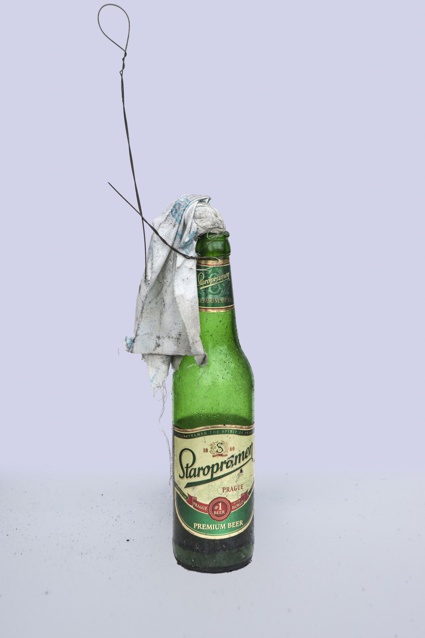 Donald Weber, Untitled. From the series Molotov Cocktails
Donald Weber, Untitled. From the series Molotov Cocktails
Molotov Cocktails have been the weapon of choice for the EuroMaidan protestors in Kiev. Using fire to their advantage, the protestors were able to defend their barricades, extend their lines and fortify their positions. In order to set fire to tanks, armoured vehicles, buses, and tires in opposition to local cops, Kievís protestors used thousand and thousands of Molotov Cocktails, inspiring and mobilizing people throughout the city to collect as many bottles as possible.
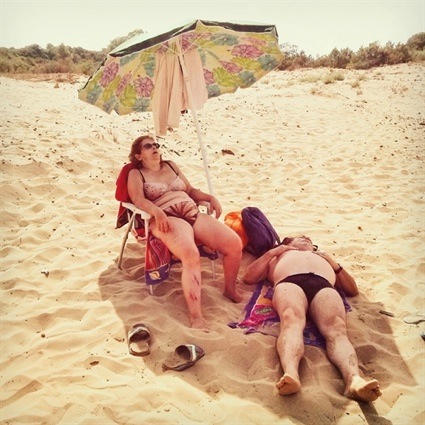 Turi Calafato (Winner Mobile Phone), A day on the beach
Turi Calafato (Winner Mobile Phone), A day on the beach
It is usual to see scenes like this because people spend all day along at the beach and all the usual activities, like playing, eating, sleepping, etc., are done outdoors. All kind of people are seen, and it is a pleasure to contemplate at the same time so much of humanity enjoying and relaxing under the sun.
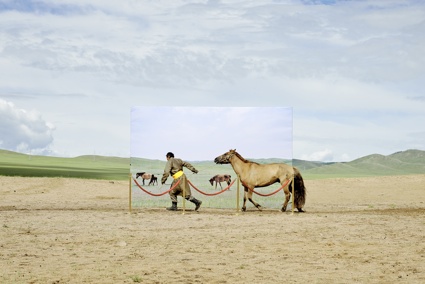 Daesung Lee (2nd place Conceptual), Untitled. From the series Futuristic Archaeology
Daesung Lee (2nd place Conceptual), Untitled. From the series Futuristic Archaeology
35% of Mongolians are living a nomadic life and depend on their land for survival. This is increasingly difficult due to serious changes: 25% of the Mongolian land has turned into desert in the past 30 years. Potentially 75% of the territory is at risk of desertification. These environmental changes directly threaten the Mongolian nomadic way of life, which has been passed from generation to generation. This project attempts at recreating the museum diorama with actual people and their livestock in a real place where decertifying is taking place. It is based on an imagined image that these people try to go into museum diorama for survival in the future. This is accomplished with printed images on a billboard placed in conjunction with the actual landscape horizon.
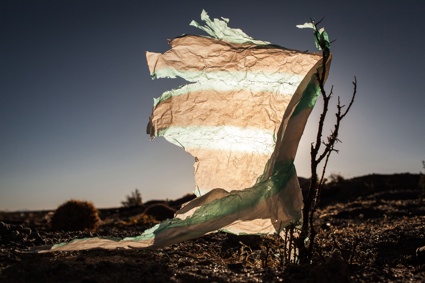 Eduardo Leal (3rd place Campaign), Plastic Tree #22. From the series Plastic Trees
Eduardo Leal (3rd place Campaign), Plastic Tree #22. From the series Plastic Trees
Plastic bags are considered the most ubiquitous consumer item in the world, but this has become the main source of pollution worldwide. Unfortunately, the properties that make it so useful such as its durability, weight and low cost also turn it into a problem, which is even more acute in developing countries where waste management infrastructures are not developed and where the population is used to throw everything away. This accumulation of plastic bags in the environment cause deterioration of the landscapes and agricultural soils and it is associated with the death of domestic and wild animals. This series, Plastic Trees, was made to call for attention on this problem, focusing on the spreading of plastic bags on the Bolivian Altiplano, where millions of bags travel with the wind until they get entangled in native bushes, damaging the beautiful landscape.
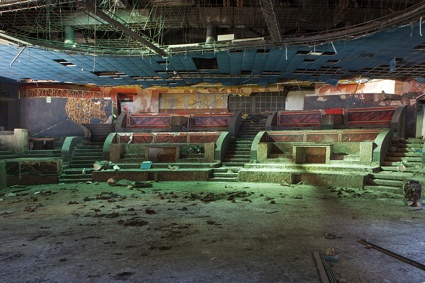 Antonio La Grotta (3rd place Architecture.) From the series Paradise Discotheque
Antonio La Grotta (3rd place Architecture.) From the series Paradise Discotheque
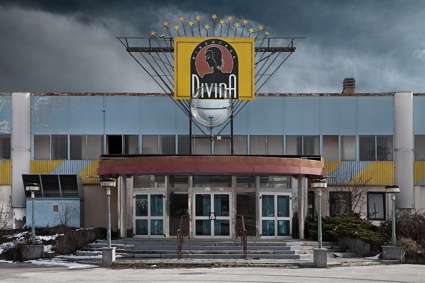 Antonio La Grotta. From the series Paradise Discotheque
Antonio La Grotta. From the series Paradise Discotheque
Discotheques, the symbol of 80s and 90s hedonism, were fake marble temples adorned with Greek statues made of gypsum, futuristic spaces of gigantic size, large enough to contain the dreams of success, money, fun of thousands people. And then the dreams are gone, people disappeared and nightclubs became abandoned wreck, cement was laid on large empty squares, places inhabited by echo and melancholy. The grass is growing in the crack, the Discobolus is hiding under a porch, priggish Venus lurks behind the bars. The Paradise Discotheque, contemporary monuments of our civilization, are waiting to be burned to the ground, and in this expectation made of vacuum, only the memory of a former glory remains.
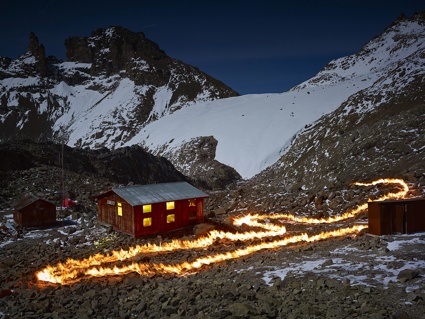 Simon Norfolk, (Landscape Photographer of the Year), Mt Kenya 1963(a). From the series When I Am Laid In Earth
Simon Norfolk, (Landscape Photographer of the Year), Mt Kenya 1963(a). From the series When I Am Laid In Earth
These fire lines I have drawn indicate where the front of the rapidly disappearing Lewis Glacier was at various times in the recent past; the years are given in the titles. In the distance, a harvest moon lights the poor, doomed glacier remnant; the gap between the fire and the ice represents the relentless melting. Relying on old maps and modern GPS surveys I have rendered a stratified history of the glacier’s retreat. Mount Kenya is the eroded stump of a long-dead, mega-volcano. Photographically, I hope to re-awaken its angry, magma heart. My fire is made from petroleum. My pictures contain no evidence that this glacier’s retreat is due to man-made warming (glaciers can retreat when the don’t get sufficient snow, or if the cloud cover thins, for example,) but it is nonetheless my belief that humans burning hydrocarbons are substantially to blame.
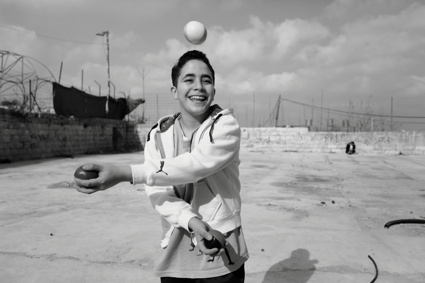 Rich Wiles, (3rd place Arts & Culture), Untitled
Rich Wiles, (3rd place Arts & Culture), Untitled
The Palestinian Circus School was established in 2006. In 2011 it moved into its own premises in Birzeit near Ramallah. Around 150 young people participate in regular circus classes which accommodate different age groups and ability levels. The school’s policy affirms that no student will ever be turned away if they cannot pay the tuition fees. Gender equality is considered an intrinsic aspect of the circus school’s structure and practice. Weekly workshops are held in refugee camps and cities across the West Bank for people unable to attend the school in Birzeit. The school has implemented performance tours in various European countries. Exchange programs have been established with European circuses to host qualified trainers and performers in Palestine. The Palestinian Circus School fuses contemporary culture with Palestinian storytelling and identity. The first production, Circus Behind the Wall, explored Palestinian separation from family, land and water by Israel’s Wall.
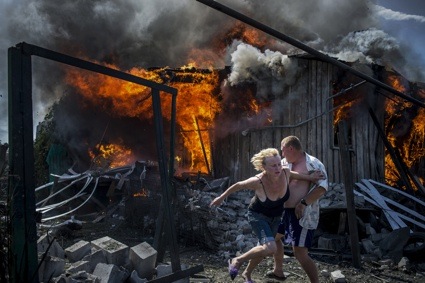 Valery Melnikov (2nd place Current Affairs), Civilians escape from a fire at a house destroyed by air attack in the Luhanskaya village. From the series Black days of Ukraine
Valery Melnikov (2nd place Current Affairs), Civilians escape from a fire at a house destroyed by air attack in the Luhanskaya village. From the series Black days of Ukraine
These pictures were taken in June-July near the city of Luhansk (Luhanskaya village). I arrived there half an hour after Ukrainian army airstrikes. Buildings were destroyed and blazed, some locals were dead, while others were escaping in fear. In 2014 the conflict between rebels and the government army in Ukraine led the country into full-scale hostilities. The local residents of the strategically located city of Luhansk were left without water and electricity for three months over the summer, while constant gunfire could be heard above their heads.
According to the Federal Migration Service, more than 800 thousand Ukrainian citizens had to be relocated as a result of the conflict.
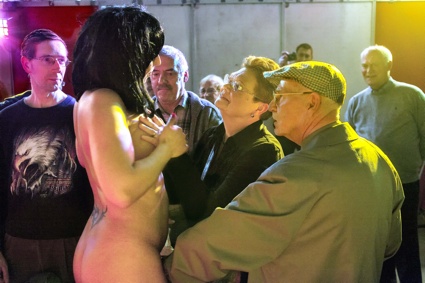 Liza Van der Stock (3rd place People), Performance at the erotic fair, 2015. From the series Paradise Lust
Liza Van der Stock (3rd place People), Performance at the erotic fair, 2015. From the series Paradise Lust
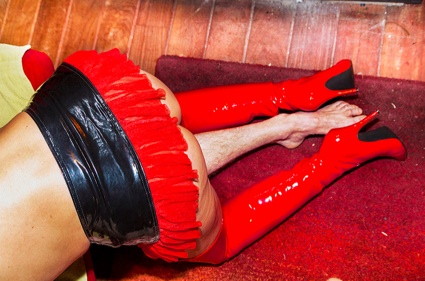 Liza Van der Stock, Performance at the erotic fair, 2015. From the series Paradise Lust
Liza Van der Stock, Performance at the erotic fair, 2015. From the series Paradise Lust
In a Flemish village, surrounded by nature, Laura and Maurice live together with their daughter Eva. In the garden, Eva plays with her dog or meets with her classmates. Friends and family come along and fill the house with activity. But when Eva is at school, Maurice and Laura shoot what most people prefer to keep to themselves. The porn they make is not populated by Barbies or muscled superheroes. Ordinary women play with men who are also dad or neighbour. A humanity that not only exists in the porn they make, but also emerge behind the scenes and in their family life. In recent years, Laura has built strong bonds with a number of like-minded people: every one of them confident women who have consciously chosen this lifestyle and only depend on themselves with respect to their work. On a regular basis, they go to erotic fairs, rendez-vous evenings or an erotic nightclub: to make money or to have fun – or both.
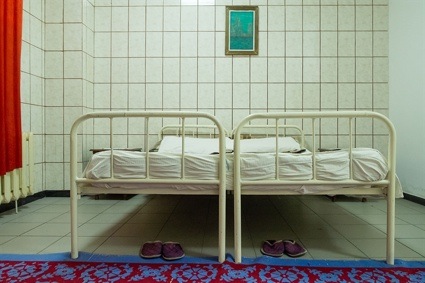 Cosmin Bumbut (Architecture Photographer of the Year), Intimate Room, Targsor Penitentiary, Romania, 2011. From the series Intimate Rooms
Cosmin Bumbut (Architecture Photographer of the Year), Intimate Room, Targsor Penitentiary, Romania, 2011. From the series Intimate Rooms
Romania joined the European Union in 2007, the whole prison system went through major revamp and the biggest reform was to introduce the right to private visits. This means that a prisoner who is married or in a relationship has the right to receive, every three months, a two-hour private visit which takes place in a separate room inside the prison compound. Plus, if a prisoner gets married in detention he or she can spend 48 hours with the spouse in the special room and is allowed visits once a month in the first year of marriage. I started photographing the private rooms in 2008 and I have now photographed the private rooms inside all Romanian penitentiaries (35 penitentiaries).
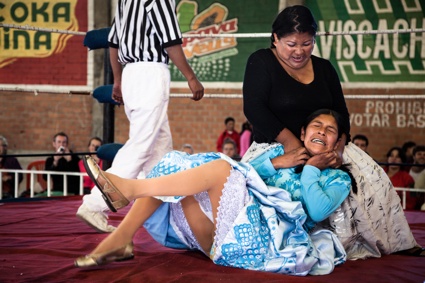 Riccardo Bononi (Sport Photographer of the Year), Untitled. From the series Las Valkyrias de Bolivia
Riccardo Bononi (Sport Photographer of the Year), Untitled. From the series Las Valkyrias de Bolivia
Bolivia is proud of being the Latin American country with the highest the number of actively working women. Bolivian women no longer are the subject for the ìweaker sexî prejudice, they are rather associated with the outstanding physical stamina, the inclination to struggle and the great brute strength. Then must not be surprising the fact that, in the poorest neighbourhood of La Paz (4000 mt), a bunch of female farmers from the countryside get together every Sunday in the ring for a public fight. Wearing the traditional cholitas (the term originally refers to the ìindigenous mixed raceî people) clothes and bowlers, Bolivian Valkyries deal with even more demanding fights once they get off the ring, raising their children all by themselves and working between the fields and the urban street markets.
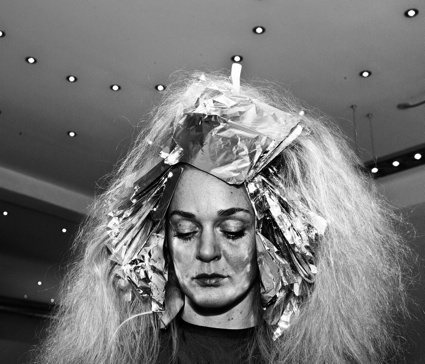 Jens Juul (3rd place Portraiture), Hair, 2015
Jens Juul (3rd place Portraiture), Hair, 2015
I started visiting different hair salons to capture the moment where we let other people get intimately close and shape the way the world sees us. When I meet ordinary people, I’m intrigued by the fact that they have so many fascinating stories and interesting personalities. Meeting strangers and getting to hear a chunk of their lives really gets me. In this case the stories were found at the local hairdresser. The project is not yet finished – there is still so much to discover in Copenhagenís smaller hair salons.
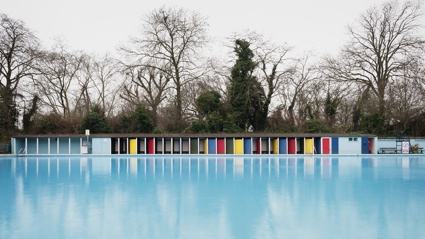 Jonathan Syer (2nd place Campaign), Tooting Bec Lido, London. From the series Lidos Of England: Lost & Found
Jonathan Syer (2nd place Campaign), Tooting Bec Lido, London. From the series Lidos Of England: Lost & Found
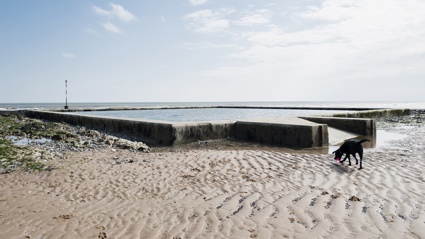 Jonathan Syer (2nd place Campaign), Broadstairs Lido, Broadstairs, Kent, UK. From the series Lidos Of England: Lost & Found
Jonathan Syer (2nd place Campaign), Broadstairs Lido, Broadstairs, Kent, UK. From the series Lidos Of England: Lost & Found
Lidos were perhaps at their most popular between the wars when people took their holidays here in England. Many of them were built in the 1930s or earlier and were naturally located on the English south coast, which was a favoured holiday destination for those living in London and the home counties. However there were many that were built in towns and cities to cope with the demand that once was and many of these remain. However, when the affordability of overseas holidays started to emerge in the 1960s many of these lidos fell into decline and have never recovered. Some have survived and have benefited from investment and so have taken on a new lease of life as popularity has started increasing again. Most have been left to decay or lost under modern developments, such as Ramsgate’s once booming pool which is now under a car park.
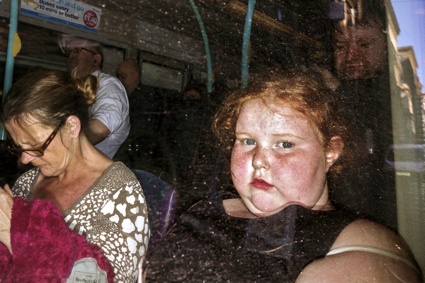 Dougie Wallace, image from the series Glasgow; Second City of The Empire
Dougie Wallace, image from the series Glasgow; Second City of The Empire
In Iraq, life expectancy is 67. Minutes from Glasgow city centre, in Calton, it is 54. I looked at this community and the day-to-day lives of its inhabitants. My intention was to juxtapose Glasgow with the vastly different setting of Kensington and Chelsea in London. Being from Glasgow and familiar with the landscape, I am moved by what I perceive to be missing chunks of life and the bleakness of those shortened lives lived in the Calton compared to those lived in Kensington and Chelsea. The difference in fortunes is not only apparent in mortality but in the cut of their suits and coats, the accessories they carry, the way the women apply their make-up, even their expressions tell a tale, confident and haughty vs downtrodden and malnourished.
(i LOVE that series.)
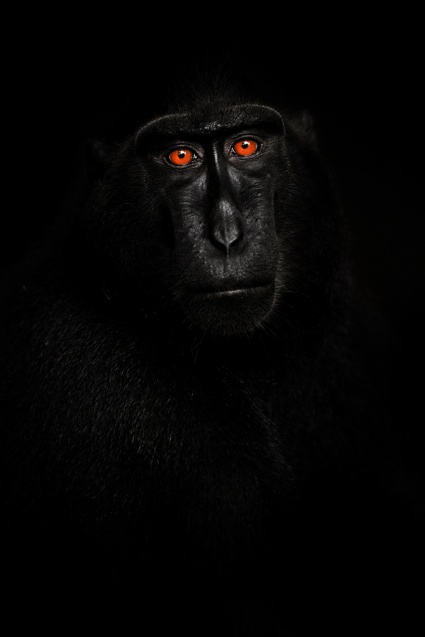 Petr Bambousek (3rd place, Czech Republic, National Award), Crested Macaque / Makak chocholat˝
Petr Bambousek (3rd place, Czech Republic, National Award), Crested Macaque / Makak chocholat˝
I walked along with enormous macaque troop on Sulawesi tens of hours and learned many about their behavior. At one moment the troop rested all around me, babies played each other while adults checked surrounding if it is safe enough. I noticed there is one male in dark shades nearby.
The winning photos of the World Photography awards are exhibited at Somerset House, London until 10th May 2015.
Image on the homepage: © Marcin Klocek, Poland, Sport, Shortlist, Professional Commpetition, 2015 Sony World Photography Awards.
